- TOP
- About Kokugakuin University
- Our academic genealogy
Our academic genealogy
Ever since its earliest days established as the Koten Kokyusho (Research Institute for the Japanese Classics) in 1882, Kokugakuin University has, in accordance with its founding philosophy, engaged in research into the theory and application of a diverse range of fields of study and provided instruction based on the knowledge thereby acquired, and made efforts to develop and expand the university in order to nurture talented individuals. This page walks you through the history of Kokugakuin University illustrated with historic photographs.
Meiji Period
Koten Kokyusho established
“Koten Kokyusho,” the parent institution of Kokugakuin University, was established in 1882. Arisugawa no Miya Takahito Shinnō (Prince Arisugawa), was the first Controller General. The institution was located in Iidamachi, Kojimachi-ku, Tokyo (present-day Iidabashi, Chiyoda-ku, Tokyo). Classes commenced on September 1 and the opening ceremony was held on November 4. This was where our university took its very first steps in public.
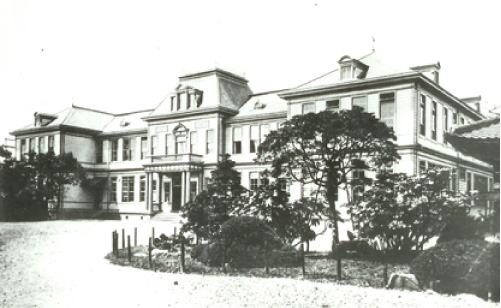
The Iidamachi Campus of Koten Kokyusho (early 20th century)

Arisugawa no Miya Takahito Shinnō (Prince Arisugawa),
Member of the Imperial Family and first Controller General of Koten Kokyusho
1812–1886
Arisugawa no Miya Takahito Shinnō (Prince Arisugawa) was the eighth head of the Arisugawa-no-Miya household, one of the four “shinnoke” cadet branches of the Imperial Household of Japan that were entitled to provide a successor to the imperial throne. He was promoted to the rank of Ippon (the “first order” of imperial princes) as a result of his achievements in his position as Emperor Meiji’s calligraphy instructor, and it was he who was tasked with writing out the official copy of the Meiji Charter Oath. He had a deep affinity with Shinto, and soon after the Meiji Restoration (1868) he was appointed as the first Governor General of the Shinto Section (Jingi Jimuka), then in 1881 he was appointed as the Controller General of the Office of Preceptors (kyōdōshoku). In February 1882 he assumed the position of the first Controller General of the Koten Kokyusho with the aim of training personnel to work in the Shinto field and contributing to the research of Japan’s classical literature, and he devoted himself to the founding, maintenance, and development of the institution. The Official Notice he issued at the Koten Kokyusho inauguration ceremony on November 4 of the same year provided the basis for Kokugakuin University’s founding philosophy. The Official Notice called for acquiring the deep understanding of the essential nature of Japan based on traditional culture through the clarification of Japan’s national characteristics as well as the cultivation and nurturing of people’s personalities.
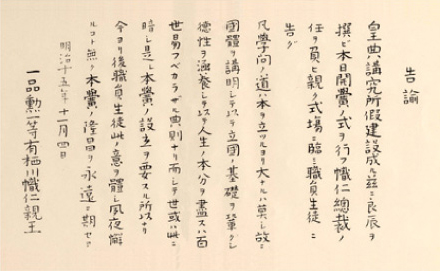
Prince Arisugawa Takahito’s Official Notice

Takemichi Koga
Nobleman, marquis, and first vice-president of the Koten Kokyusho
1815–1903
Descended from the Murakami Genji branch of the Imperial Family, the Koga house was a court noble family of the very highest pedigree, ranked below only the five families of the Fujiwara clan (Gosekke), and Takemichi was the 34th head of the household. He held the post of high priest of Kamowake-Ikazuchi Shrine and Kamomioya Shrine. In 1882 he accepted an invitation to become the vice-president of the Koten Kokyusho from the Controller General of the institution, Prince Arisugawa. He devoted himself for a long time to the development of the Koten Kokyusho and Kokugakuin until his death in 1903. Beginning in 1931, sets of documents relating to the Koga house were entrusted to Kokugakuin University on three separate occasions, and in 1951 these were donated to Kokugakuin. In 1988 the majority of these documents (2,461 of them) were designated by the government as “Important Cultural Properties.”
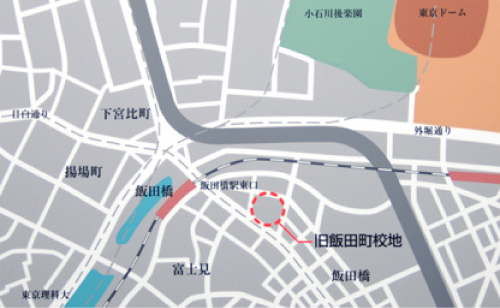
The former site of the Iidamachi campus (location indicated on a contemporary map of the area)

Takayuki Sasaki
Statesman, marquis, and director of Koten Kokyusho/president of Kokugakuin
1830–1910
Born in Tosa Province (present-day Kochi Prefecture). He was a close friend of Ryoma Sakamoto, who was from the same town, and, as an imperial loyalist, participated in the movement advocating the restoration of imperial rule and overthrow of the Shogunate. He gained the deep trust of Emperor Meiji, and following the Meiji Restoration he served as a statesman and an Imperial Family tutor, among other roles. In 1896 he assumed the roles of the director of Koten Kokyusho and the president of Kokugakuin, and he pushed forward with reorganization of the management of both institutions and enhancement of the education they provided. Takayuki’s heir, Takami, also worked tirelessly with him on developing the Koten Kokyusho and Kokugakuin, and his grandson Yukitada also served as the director of Koten Kokyusho and the president Kokugakuin before, during, and after WWII. The book collections of the three Sasaki generations were donated to the Kokugakuin University Library, where they are now stored.
Establishment of a Shinto priest training faculty
Shinto priest training workshops, which had been held since 1900, were reorganized and a Shinto priest training faculty (with a Shinto priest practical learning department, Shinto priest theory department, and Shinto ritual theory department) was established.
Mizuhokai launched
Koten Kokyusho’s alumni association, Mizuhokai, was launched. The Kokugakuin University Alumni Association traces its roots back to the launch of the Mizuhokai.
The birth of Kokugakuin
In July, “Kokugakuin,” an educational organization formed to engage in research into Japanese history, literature, and law (undergraduate course: 3 years, graduate course: 2 years), was established with Koten Kokyusho as its parent institution. This was the first appearance of the name “Kokugakuin.”

Akiyoshi Yamada
Statesman, count, first director of Koten Kokyusho
1844–1892
Born in Nagato Province (present-day Yamaguchi Prefecture). At the age of 14 he entered Shoin Yoshida’s Shokasonjuku Academy, and after Yoshida was sentenced to death, Yamada worked with Shinsaku Takasugi and others on launching the movement advocating the restoration of imperial rule and overthrow of the Shogunate. He applied what he learned about Western military tactics, particularly from Masujiro Omura, to the establishment of a modern military system following the Meiji Restoration. From 1874 onward he served as vice-minister (Shiho-taifu) and administrator (Shiho-kyo) at the Ministry of Justice, devoting himself to the establishment of Japan’s modern legal system. With the introduction of the cabinet system in 1885 he was appointed as the first Minister of Justice. Prior to this, in 1882, as an administrator of the Ministry of Justice he was involved in the creation of the Koten Kokyusho. In 1888 he gave a talk at the Koten Kokyusho on the importance of Japanese culture in Japan’s constitutional governance. In 1889 he was appointed as the Koten Kokyusho’s first head. In 1890 he published the Kokugakuin’s founding charter, which led to the establishment of Kokugakuin with the Koten Kokyusho as its parent institution.

Isao Matsuno
Japan studies scholar and secretary of research at Koten Kokyusho
1852–1893
A Japan studies scholar from Bingo Province (present-day Hiroshima Prefecture). In 1872, he set his aim and moved to Tokyo, and he became a servant and student of Kanetane Hirata, the successor of Atsutane Hirata. He was involved in the creation of Shinto and Japan studies research/educational institutions such as the Shinto Office’s student dormitory and the Jingu Kyoin Honkyoin (Grand Shrine Teaching Institute’s main teaching hall). In 1882 he carried out a variety of tasks relating to the opening of Koten Kokyosho as the person placed in charge of the institution’s establishment. In 1890 he assisted Akiyoshi Yamada, the first director of the Koten Kokyusho, by drafting the founding charter of the Koten Kokyusho for example, and played an important role in the establishment of Kokugakuin. Following the establishment of the Koten Kokyusho and Kokugakuin, he continued to be a central figure on the operational side of both institutions and devoted his energies to their maintenance and development. In 1922, thirty years after his death, a biography entitled “Matsuno Isao Sensei” was penned by Shigematsu Mitsuya, a member of the very first Kokugakuin student class, and professor of Kokugakuin University. In the biography, Professor Shigematsu paid tribute to Mr. Matsuno in the following manner: “As long as Koten Kokyusho and Kokugakuin University continue to exist, Matsuno Sensei’s name will not be forgotten, and his achievements will endure.”

Kowashi Inoue
Statesman, public official, and viscount
1844–1895
As a statesman and public official in the Meiji government, Viscount Inoue contributed to the drafting of the Meiji Constitution, the Meiji Imperial Household Law, and the Imperial Rescript on Education, and was also involved in the establishment of a variety of policies and legislation relating to the modernization of Japan. Together with Akiyoshi Yamada, he played an important role in the development of the Koten Kokyusho and Kokugakuin in the early days through, for example, giving talks at the Koten Kokyusho on the idea that studying the law of a nation would be the foundation of constitutional government and national education, and his involvement in revisions to Kokugakuin’s founding charter. His archival collection of materials, the “Goin” collection (“Goin” was his penname) was entrusted on a permanent basis to Kokugakuin University’s library in 1957 and donated in 1983, and is stored in the library’s archives.
First issue of the “Kokugakuin Zasshi” journal published
Koten Kokyusho certified as an “incorporated foundation”
Kokugakuin renamed “Shiritsu Kokugakuin” (shiritsu=private)
In April, the institution was promoted to the status of vocational college in accordance with a Vocational Colleges Edict and was renamed “Shiritsu Kokugakuin” (university preparatory course: 2 years, undergraduate course: 3 years)
Renamed “Shiritsu Kokugakuin Daigaku”
In June, Kokugakuin was renamed “Shiritsu Kokugakuin Daigaku” (Kokugakuin private university) in accordance with a public notice of the Ministry of Education.
Taisho Period
Promoted to the status of university in accordance with a Universities Edict
In accordance with an edict on April 15, Kokugakuin was promoted to the status of university making it a member of the first group of private institutions to be certified as universities (the others being Keio Gijuku, Waseda, Meiji, Chuo, Nihon, Hosei, and Doshisha).
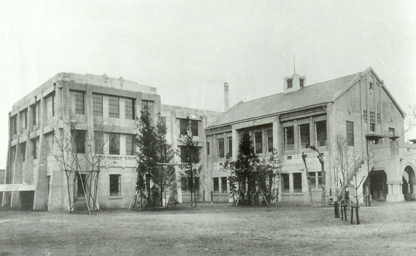
The Shibuya campus during Japan’s Taisho period (1912 to 1926)

Shigematsu Mitsuya
Scholar of literature
1872–1924
A member of the first Kokugakuin student class that entered the institution in 1890 and graduated in 1893. After graduating he joined the Ministry of Education (the present-day Ministry of Education, Culture, Sports, Science and Technology) but subsequently resigned to pursue a career as an educator. While educating students from China at a school called Jiraku Shoin, founded by the judo practitioner and educator Kano Jigoro, he also worked as a teacher at Kokugakuin. In 1918, he became a professor at Tokyo Koto Shihan Gakko (present-day Tsukuba University), and in 1920 he became a professor at Kokugakuin University. He published a large number of research papers mainly on the study of the Japanese language, establishing the so-called “Mitsuya Bunpo” method. In 1923 he earned the first Kokugakuin University PhD in literature with his “Studies on Special Method of Readings in the Kojiki.” He educated Shinobu Orikuchi and Yukichi Takeda and laid the foundation for Kokugakuin University’s Japanese literature studies.
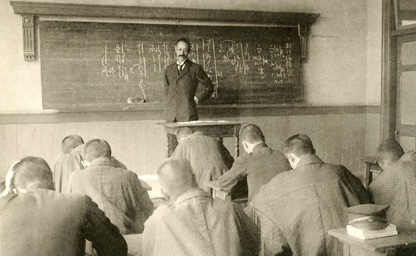
Professor Shigematsu Mitsuya teaching a class (1916)
New campus constructed on imperial property in Shibuya
The number of students was increasing and plans for a largescale campus expansion got underway in 1918. The new building was completed in May 1923 on imperial property in Shibuya (the same site as the present-day campus) and classes commenced in June. Although the building suffered damage from the Great Kanto Earthquake in September, the following year the repair work was completed and the official school song and flag were selected. The university continued to grow and develop steadily into the 1930s and 1940s.
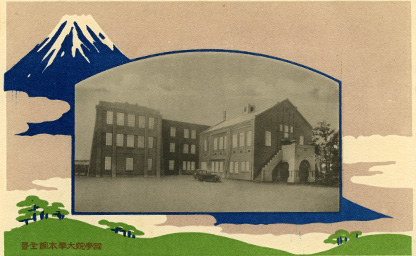
A postcard commemorating the post-earthquake restoration of the campus.
Showa Period
Library opening ceremony held
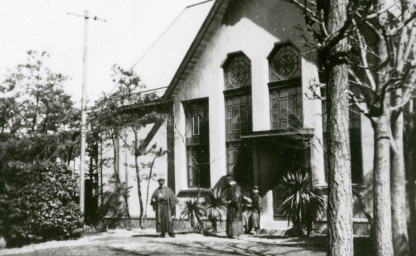
The library, which opened in 1927.

Yaichi Haga
Scholar of literature
1867–1927
The son of a Japan studies scholar. After returning to Japan from studying in Germany, he applied German philological methods to Japan studies and built the foundations for research into modern Japanese literature. He is extolled as the father of Japanese literature scholarship. He worked as a professor at Tokyo Imperial University (the present-day University of Tokyo), earned a PhD in literature in 1903, and later became a professor emeritus at Tokyo Imperial University. In 1918 he assumed the role of president of Kokugakuin University, and worked toward enabling Kokugakuin to gain promotion to the status of university in accordance with the Universities Edict in 1920, and oversaw the move from the Iidamachi (Iidabashi) campus to the current location in Shibuya. He also wrote the lyrics to Kokugakuin University’s official song. In 1927 he was awarded the First Class Order of the Sacred Treasure. Today he is regarded as one of the forefathers responsible for Kokugakuin’s revival, and a bust of his likeness is now situated just inside the main gate on the left.
Construction work on the great auditorium completed
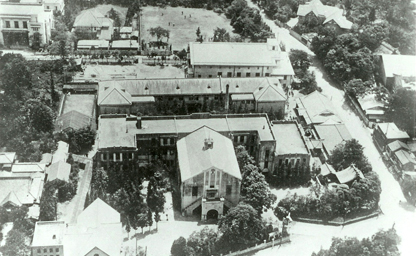
Panorama of the Shibuya campus (photograph taken between 1935 and 1945)

Iwakichi Ishikawa
Educator
1875–1960
A member of the third student class at Kokugakuin. Graduated in 1895. He taught Japanese ethics and national morals, and was involved in the operational/administrational side of Kokugakuin University. At the recommendation of Dean Jugo Sugiura, he tutored members of the Imperial Household, and in 1936, as a Togufuikukan (an educational expert for the Crown Prince), he was responsible for tutoring Crown Prince Akihito, who is now the reigning Emperor of Japan. He became the head director/president of Kokugakuin University at the height of the confusion in the immediate aftermath of WWII, and devoted himself to the maintenance and development of the university. After resigning from the post he was bestowed the title of honorary president. Today, he is regarded as one of the forefathers responsible for Kokugakuin’s revival, and a bust of his likeness has been placed in the university grounds.

Kunio Yanagita
Japanese folklorist
1875–1962
Yanagita is the founder of Japanese folklore studies. He joined the Ministry of Agriculture and Commerce, and while serving as the chief of the recording section of the Chief Cabinet Secretary and Chief Secretary of the House of Peers, he published a book called “Tono Monogatari” that focused on traditional folklore and also launched Japan’s first folklore journal, “Kyodo Kenkyu.” After quitting public office he served as a guest editorialist for the Asahi Shimbun newspaper and worked for a time in Geneva as a member of the League of Nations Permanent Mandates Commission. In 1951 he was awarded the Order of Cultural Merit and in the same year also lectured on Shinto Studies as a professor at the Graduate School of Letters of Kokugakuin University.
Night courses commenced

Shinobu Orikuchi
Japanese folklorist
1887–1953
Orikuchi opened up new ground in the field of Japanese folklore studies and this area of learning is called “Orikuchi-gaku,” or, “Orikuchi-ism.” He had an affinity from a young age for poetry, kabuki and other mediums, and at Kokugakuin University he studied under Shigematsu Mitsuya. He became the leading disciple of Kunio Yanagita and followed the path of folklore studies. His study approach involved applying the research methods of folklore studies to Japan studies with the aim of grasping how the heart and soul of the Japanese people has been transmitted from ancient to modern times. In 1919 he became a Kokugakuin University lecturer and later a professor, and from 1928 also worked as a professor at Keio University. Under the penname Shakuchoku he also engaged in a wide range of creative activities including the writing of tanka, poetry, and novels.
Faculty of Letters established under a new system
Kokugakuin High School established, incorporating Mejiro Academy
Faculty of Letters night courses and the establishment of the Faculty of Political Science (renamed “Faculty of Politics and Economics” in 1950)
Classes commence at the Mejiro campus and the Faculty of Political Science established there
Archaeology resources room opened
Master’s Course in Japanese History established at the Graduate School. Archaeology resources room was opened (in 1955 the Ministry of Education issued a proclamation designating the resources room as a facility corresponding to a museum).
Kugayama Gakuen (Kugayama High School and Kugayama Junior High School) incorporated into Kokugakuin
Kokugakuin University kindergarten teacher training facility established. Institute for Japanese Culture and Classics established
The Kokugakuin University kindergarten teacher training facility established (now called the Training College of Infant Education Attached to Kokugakuin University). Institute for Japanese Culture and Classics was established.
Shinto Program (Advanced Shinto Training Course) and Shinto Studies Doctoral Program established
Tateshina Dormitory opened

Iwao Oba
Archaeologist
1899-1975
A graduate of Kokugakuin University. Prior to WWII he joined the Ministry of Home Affairs’ Bureau of Shrines (which administered Shinto shrines) and conducted research and historical investigations on shrines and religious ruins throughout Japan. At the same time he also worked as a lecturer at Kokugakuin University, and after WWII he laid the foundations for Kokugakuin University’s archaeology research laboratory as a professor at the university. He carried out surveys of archaeological sites such as the Toro site in Shizuoka Prefecture, and at the Utsugi-Mukohara archaeological site he coined the term “Hokeishukobo” (graves with quadrilateral enclosures). Through exchanges with Shinobu Orikuchi and Naokazu Miyaji, he began to advocate the incorporation of folklore studies and Shinto history methodology into Shinto archaeology.
Dr. Orikuchi Memorial Ancient Research Institute established
Law Department night courses commenced. The Dr. Orikuchi Memorial Ancient Research Institute was established. The Dr. Takeda Memorial Room was subsequently opened in 1966, and the Dr. Kono Memorial Room was opened in 1970.
Master’s program in economics research established
Kokugakuin Kindergarten opened
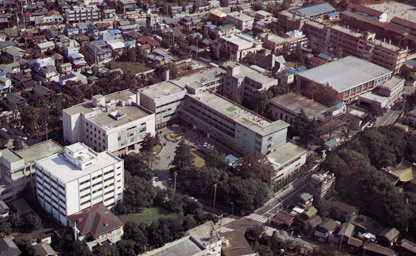
Shibuya campus (in 1969)
Kokugakuin University kindergarten teacher training facility reorganized into the Training College of Infant Education Attached to Kokugakuin University
Kokugakuin University kindergarten teacher training facility (a vocational school) was reorganized into the Training College of Infant Education attached to Kokugakuin University (a specialized training college).
Construction of the Hyakushunen Kinenkan completed
Construction of Hyakushunen Kinenkan (Centennial Hall) completed. Shin-Ishikawa school building constructed at the Kanagawa Undojo.
Construction of the Shin-Ishikawa schoolhouse (the present-day Yokohama Tama-Plaza Campus) completed and classes commenced
Installation of a monument marking the site of the Koten Kokyusho in collaboration with Nihon University (Iidabashi 3-5-5, Chiyoda-ku, Tokyo)
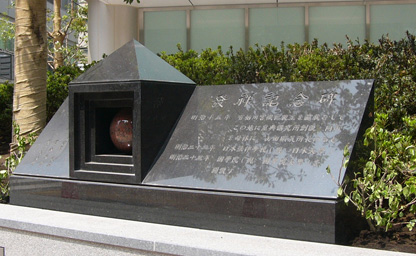
Monument marking the site of the Koten Kokyusho
Shrine established
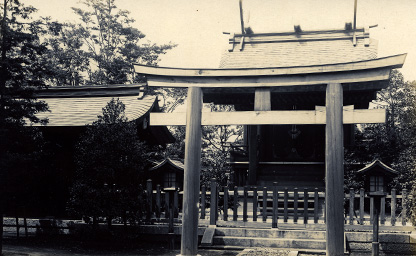
The shrine at the time of its establishment
50th anniversary ceremony held
The 50th anniversary was held on November 4, and was attended by His Imperial Highness Prince Takamatsu (Takamatsu-no-Miya Nobuhito).
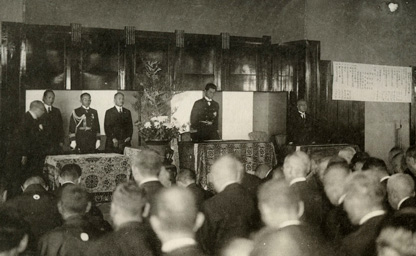
The 50th anniversary ceremony

Kyosuke Kindaichi
Japanese linguist
1882–1971
A pioneer in the field of research into Ainu languages. He carried out fieldwork in Karafuto, Hokkaido, and studied Ainu languages, literature, and folklore in a systematic manner. In 1932 he was awarded the Imperial Prize of the Japan Academy for his “Ainu Jojishi Yukara no Kenkyu” (Study of “Yukar,” the Ainu Sagas). Later in his life he compiled and published an anthology of Ainu Yukar sagas. He lectured on linguistics and Japanese language studies at Kokugakuin University from 1908 and became a professor in 1922. In 1954 he was awarded the Order of Merit. The poet Takuboku Ishikawa was an old close friend of his, and he penned a memoir about him titled “Ishikawa Takuboku.” The fictional detective Kosuke Kindaichi in a novel by Seishi Yokomizo was named after him.

Seizo Kono
Shinto scholar
1882–1963
The son of the head priest of Tamashiki Shrine in Saitama Prefecture. After graduating from Kokugakuin University, he became a teacher. In 1935 he became the first Kokugakuin graduate to assume the post of president of Kokugakuin University. As an authoritative figure in the field of Shinto studies he published a large amount of research centering on Shinto thought, beliefs, and morals. His research activities were underpinned by the vast archive that he personally collected together, which after his death was entrusted/donated to Kokugakuin University. The archive was used for subsequent Shinto research and has continued to contribute substantially to the development of Shinto studies to this day.
The Kokugakuin University “incorporated foundation” established
Koten Kokyusho was dissolved and the Kokugakuin University incorporated foundation was established. Kokugakuin was ahead of other universities in instituting a coeducational system.

Yukichi Takeda
Literary scholar
1886–1958
Graduated from Kokugakuin University. He was involved in the compilation of the “Kohon Manyoshu” at Tokyo Imperial University (the present-day University of Tokyo). In 1926 he became a Kokugakuin University professor and in the same year, he was awarded the Silver Cup with the Chrysanthemum Crest for his achievement in discovering compelling documentation relating to the reign of Emperor Chokei. In 1950 he was awarded the Japan Academy Prize for his research into revisions to the Manyoshu. His steady and consistent research based on philological methodologies made a significant contribution to research into the Manyoshu and other ancient works of literature.
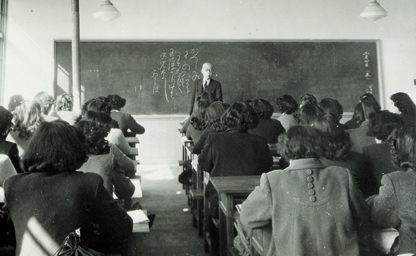
Professor Yukichi Takeda teaching a class (1957)
Transition to an “incorporated educational institution”
The “incorporated foundation” was dissolved and the incorporated educational institution Kokugakuin University was established. Faculty of Political Science and Economics night courses commenced. Graduate School of Letters master’s courses in Japanese literature and Shinto studies were established.
Graduate School of Letters doctoral courses in Japanese literature and Japanese history established
Kindergarten Attached to Kokugakuin University opened

Masajiro Takikawa
Legal scholar
1897–1992
A major figure in the field of study into the history of Japanese legal systems. His studies also encompassed the history of Chinese legal systems and government, socioeconomic history, and the history of performing arts and customs. He also proactively researched subjects that had been considered taboo until the postwar period, such as the history of prostitution. He edited, wrote, and contributed to more than 100 books. He was also deeply involved in the practice of law and served as a special lawyer at the Tokyo War Crime Trials. In a book he subsequently wrote entitled “Tokyo Saiban wo Sabaku,” he pointed out the contradiction of the Tokyo War Crime Trials being conducted against the defeated nation in a one-sided manner by the victorious allied powers. He also penned “Kojishi Kojishuku no Kenkyu” regarding Edo period court cases and a biography of Heizo Hasegawa, made famous by the television drama “Onihei Hankacho.”
Kokugakuin University Tochigi High School opened
Kokugakuin University Tochigi High School opened (the school became an affiliated independent educational body called “Kokugakuin University Tochigi Educational Institution” in 1963).
Kanagawa Undojo opened
Kanagawa Undojo (a sports facility) was opened and physical education-related classes commenced.
Faculty of Law and the Shinto resources room established
The Faculty of Law was established to mark Kokugakuin’s 80th anniversary. The Shinto resources room was opened.
Faculty of Politics and Economics reorganized into the Faculty of Economics with day and night courses

Sadafumi Fujii
Historian
1906–1994
A specialist in early modern and modern Japanese history. After graduating from Kokugakuin University he became a Meiji Restoration historiographer and worked on compiling the Dai Nihon Ishin Siryo (a compilation of historical resources on the Meiji restoration of Japan). During WWII he worked as a professor at Jakarta Medical University and after the war he joined the National Diet Library. In 1952 he became a professor at Kokugakuin University where he carried out wide-ranging research from Japanese studies to the early modern and modern history of Japanese thought, and was also involved in compiling the history of Kokugakuin University.
Doctoral program established in the Graduate School of Economics
Archaeology Resources Room renamed as the Museum of Archaeology
Kokugakuin Women’s Junior College opened
On November 4, the 100th anniversary commemoration ceremony was held and was attended by His Imperial Highness Prince Takamatsu (Takamatsu-no-Miya Nobuhito). Kokugakuin Women’s Junior College opened in Takikawa City, Hokkaido.
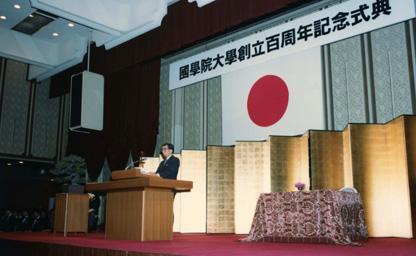
The 100th anniversary commemoration ceremony
Construction work on the Shin Inyu Kaikan Hall completed.
Heisei Period
100th anniversary of the Kokugakuin Declaration
Beginning of classes at Tama-Plaza Campus for first and second year students of all faculties
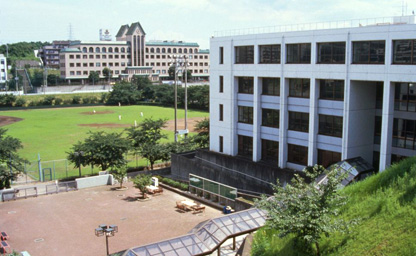
Yokohama Tama-Plaza Campus
115th anniversary commemorated
Transition of the Faculty of Law and the Faculty of Economics to a flexible day and evening lecture system
Construction work on Building No.1 to commemorate the 120th anniversary completed in February
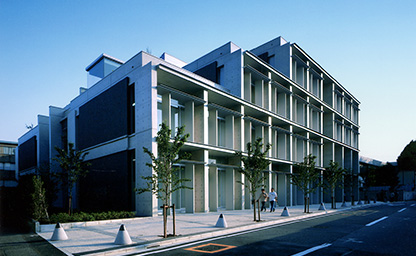
Construction work on Building No.1 completed
Law School opened. Construction work on Building No. 2 to commemorate the 120th anniversary completed in July
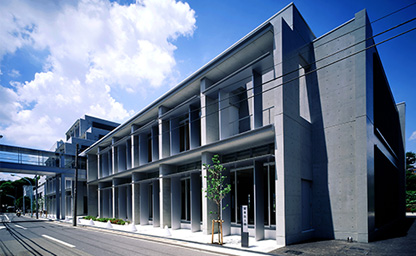
Construction work on Building No. 2 completed
125th anniversary commemorated. Organization for the Advancement of Research and Development launched in April
Construction work on Academic Media Center completed
Construction work on the Academic Media Center (a six-story building with two basement levels) was completed in March. In April the Faculty of Law switched to a seven-period system.
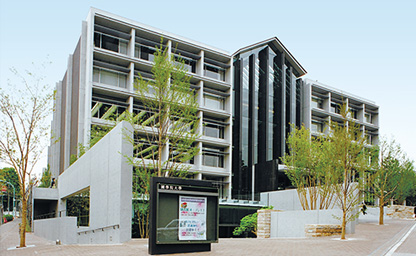
Construction work on the Academic Media Center completed
Department of Japanese Literature switched to a seven-period system
Teaching Center opened
Department of Child Studies established in the Faculty of Human Development
Kokugakuin Women’s Junior College renamed to Kokugakuin Junior College
Kokugakuin Women’s Junior College was renamed to Kokugakuin Junior College with the transition to coeducation.

Suehiro Tanemura
Scholar of German literature, essayist
1933–2004
One of the leading figures in 1960s and 1970s underground culture together with French literature scholar and critic Tatsuhiko Shibusawa and dramatist Juro Kara. He established the Genso Bungaku (fantasy literature) genre. In addition to translating German literature, he was also active as a critic and essayist. He became a lecturer at Kokugakuin University in 1978 and later became a professor. He is also known for the fact that Testushi Suwa (winner of the Akutagawa Prize in 2007) studied under him.
New departments established in the Faculty of Letters
The Department of Japanese Literature, Department of Chinese Literature, and the Department of Foreign Languages and Culture Studies were established in the Faculty of Letters. The Department of Socio-Economic Networking and the Department of Industrial Consumption Information (night courses) were established in the Faculty of Economics.
Kokugakuin Kugayama Junior High School restarted
Sagamihara Campus opened
120th anniversary ceremony held
Held on November 4, the 120th anniversary ceremony was attended by His Imperial Highness Prince Tomohito of Mikasa. The Faculty of Shinto Studies was established (with a flexible day/night lecture system). “Establishment of a National Learning Institute for the Dissemination of Research on Shinto and Japanese Culture” was selected for the 21st Century Center of Excellence Program.
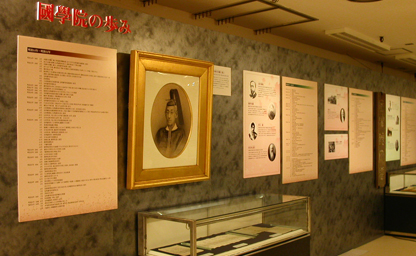
Kokugakuin University’s 120th anniversary exhibition at the head branch of Tokyu Department (November 2002)
Department of Business Management established in the Faculty of Economics
The Department of Business Management was established in the Faculty of Economics. The Faculty of Economics, Department of Chinese Literature, Department of Foreign Languages and Culture Studies, and Department of Philosophy switched to a seven-period system, while the Department of Japanese Literature and the Department of History switched to a flexible day/night lecture system.
Construction of the Wakagi Tower completed
Construction work on the Wakagi Tower (18 floors above ground and one basement level) was completed in May.
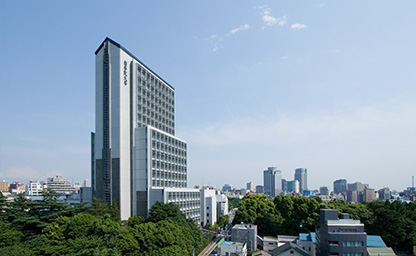
Construction of Wakagi Tower completed
Faculty of Human Development established
The Faculty of Human Development was established in April at the Yokohama Tama-Plaza Campus. The Institute for the Advancement of Teaching and Learning was opened. Kokugakuin Junior College was renamed Kokugakuin University Hokkaido Junior College. Construction work on Building No.3 was completed in September.
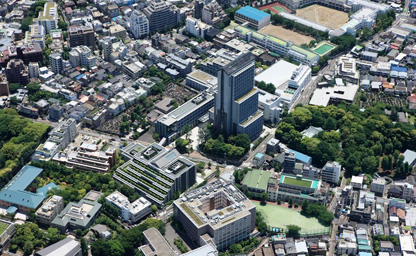
The Shibuya Campus today
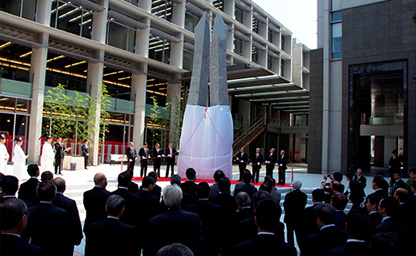
Monument unveiling ceremony
Center of Kojiki Studies estabilished
Reiwa Period
The Faculty of Economics was reorganized into two departnents,the Department of Economics and the Department of Business Management
Faculty of Tourism and Community Development established
The Faculty of Tourism and Community Development was established in April at the Yokohama Tama-Plaza Campus.
RECOMMENDS
-
{{settings.title}}
{{settings.lead.title}}
{{{settings.lead.letter}}}
{{pages.title}}
{{articles.title}}
Language
SEARCH
{{section.title}}
-
{{item.tagline}}

